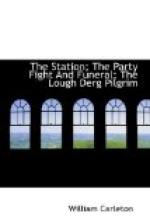* Fire at Lough Derg.—On the 15th Aug 1842, the station at this celebrated place was brought to a conclusion; but in the course of the night it was discovered that some of the houses were on fire, and four dwellings which, we believe, were recently erected, were altogether consumed. The people of the neighboring country directed their efforts chiefly to the preservation of the prior’s house, which adjoined those in flames, and by pouring a continued supply of water against its windows, succeeded in saving it. The night being calm, and the wind in a favorable direction, the injury sustained was less than must have existed under different circumstances. The houses burnt were occupied as lodgings for pilgrims when on station.
The following is extracted from Bishop Henry Jones’s account, published in 1647:
“The island called St. Patrick’s Purgatory is altogether rocky, and rather level; within the compass of the island, in the water towards the north-east, about two yards from the shore, stand certain rocks, the least of which, and next the shore, is the one St. Patrick knelt on for the third part of the night in prayer, he did another third in his cell, which is called his bed, and another third in the cave or purgatory; in this stone there is a cleft or print, said to be made by St. Patrick’s knees; the other stone is much greater and further off in the lake, and covered with water, called Lachavanny: this is esteemed of singular virtue; standing thereon healeth pilgrims’ feet, bleeding as they are with cuts and bruises got in going barefoot round the blessed beds.
“The entrance into the island is narrow and rocky; these rocks they report to be the guts of a great serpent metamorphosed into stones. When Mr. Copinger, a gentleman drawn thither by the fame of the place, visited it, there was a church covered with shingles dedicated to St. Patrick, and it was thus furnished: at the east end was a high altar covered with linen, over which did hang the image of our Lady with our Saviour in her arms; on the right did hang the picture of the three kings offering their presents to our Saviour; and on the left the picture of our Saviour on the cross; near the altar, and on the south side, did stand on the ground an old worm-eaten image of St. Patrick; and behind the altar was another of the same fabric, but still older in appearance, called. St Arioge; and on the right hand another image called St. Volusianus.
“Between the church and the cave there is a small rising ground, and on a heap of stones lay a little stone cross, part broken, part standing; and. in the east of the church was another cross made of twigs interwoven: ’this is known by the name of St. Patrick’s altar, on which lie three pieces of a bell, which they say St. Patrick used to carry in, his hand. Here also was laid a certain knotty bone of some bigness, hollow in the midst like the nave of a wheel, and out of which issue, as it were, natural spokes: this was: shown as a great rarity, being part of a great, serpent’s tail—one of those monsters the blessed Patrick expelled out of Ireland.




